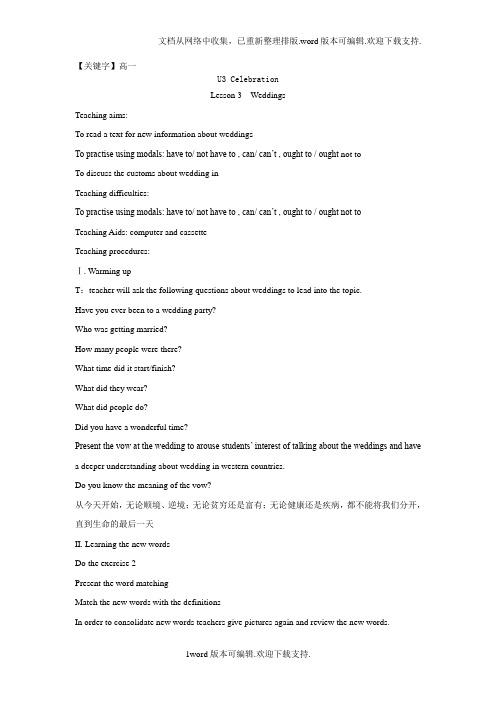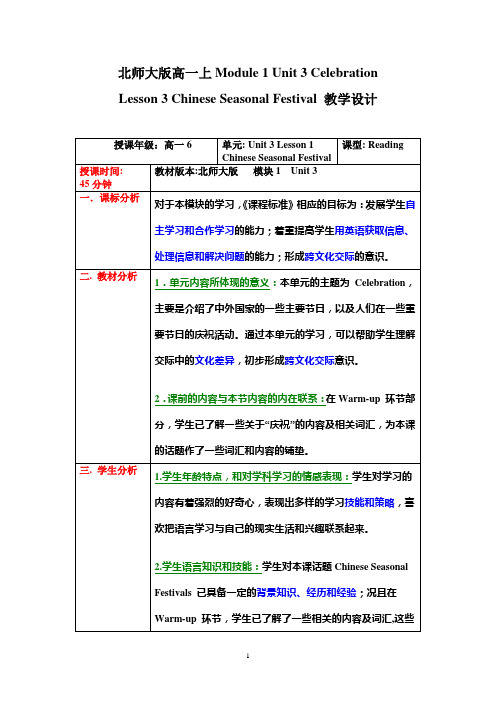北师大版英语高一上册Module 1《Unit 3 Celebration》(lesson2)
- 格式:ppt
- 大小:717.50 KB
- 文档页数:21

【关键字】高一U3 CelebrationLesson 3 WeddingsTeaching aims:To read a text for new information about weddingsTo practise using modals: have to/ not have to , can/ can’t , ought to / ought not toTo discuss the customs about wedding inTeaching difficulties:To practise using modals: have to/ not have to , can/ can’t , ought to / ought not toTeaching Aids: computer and cassetteTeaching procedures:Ⅰ. Warming upT:teacher will ask the following questions about weddings to lead into the topic.Have you ever been to a wedding party?Who was getting married?How many people were there?What time did it start/finish?What did they wear?What did people do?Did you have a wonderful time?Present the vow at the wedding to arouse students’ interest of talking about the weddings and have a deeper understanding about wedding in western countries.Do you know the meaning of the vow?从今天开始,无论顺境、逆境;无论贫穷还是富有;无论健康还是疾病,都不能将我们分开,直到生命的最后一天II. Learning the new wordsDo the exercise 2Present the word matchingMatch the new words with the definitionsIn order to consolidate new words teachers give pictures again and review the new words.Ⅲ ReadingWedding customs are different in different countries. Now we will read two articles : Weddings in Indonesia and Greek weddings,try to remember what to do and what not to do.(give students time to read the text)Enjoy the pictures about Indonesian Wedding1.Present a chart showing what to do and what not to do during the weddingWhat to do:I can go without an invitation.I can attend the reception after the ceremony.I ought to put money into the box at the entrance of the reception.What not to do:You oughtn’t to go to the ceremony without asking first.You don’t have to contribute a lot of money.You can’t drink alcohol at the wedding reception.Indonesian women don’t have to cover their heads.Enjoy the pictures about Greek WeddingsAsk the students to give information about what happens before, during and after the wedding. Before the wedding ceremonyThe bridegroom has to ask the bride’s father for his daughter’s hand in marriage.During the wedding ceremonyThe best man should help put crowns made of flowers on the heads of the couple.A long silk ribbon that links the crowns is a symbol of a long and happy life for the couple.After the wedding ceremonyThe guests can attend a wedding receptionGuests can throw dishes on the floor and put money on the bride’s wedding dress for good luck. The party can last through the night.Do the exercise3 true or falseⅣ Language points1. even if 即使Even if you know the secret you should keep silent.即使你知道这个秘密,你也应该保持沉默。

北师大版英语高一上Unit 3 CelebrationLesson1 Festivals课堂设计及教案汤阴一中分校高三(3)组:崔文魁2010-10-19北师大版英语高一上Unit 3 CelebrationLesson1 Festivals课堂设计与构思一、教学课型本节课为阅读课即讲授课二、教材分析1.教材内容分析及教材处理本节课为reading,教学内容是北师大教育出版社出版的必修1Unit3 Festivals .reading部分意在激活学生节日文化方面的图式知识和重构节日文化,并对传统节日文化有深入的认识和了解。
2.教学目标(1)通过音像、图片让学生了解有关中国传统节日文化方面的知识(2)培养学生通过快速阅读查找相关信息的技巧与能力(3)使学生能够运用本单元词汇口头描述一些节日3.教学重点及难点(1)从三个方面:时间,庆祝的内容,人们的活动深入了解中国传统节日。
(2)培养学生口头表达节日文化的能力。
三、学情分析本节课的授课对象为高三年级学生。
他们从高一开始学习新教材,在以前的学习过程中,已经积累了大量的词汇,并且具备了一定的组织语言的能力,这些都为本课的教学打下了基础。
四、教学设计1.总体思路教学过程采用任务型教学的理念。
任务前阶段,利用学生比较喜欢的音乐和歌曲以及生动形象的节日图片激活学生有关中国传统节日的知识,然后学生从三个方面,即:时间;庆祝的内容和人们的活动来系统认识中国传统节日,最后,要求学生通过做游戏的方式了解中国传统节日和培养学生口头表达英语的能力,从而巩固了对中国传统节日的系统掌握。
2.教学过程Step 1: Lead-in设计说明:利用音乐和歌曲激活学生已有的有关节日的背景知识和知识结构,从而导入本单元的话题:节日Step 2: Picture presentation设计说明:通过多媒体展示图片信息让学生形象感知节日事件和节日气氛,并联系生活经验,说出该节日的名称。




《unit 3 lesson 1 Chinese Seasonal Festivals》教学指导Objectives■To use pictures to help understand new words and to use the dictionary to check meanings.■To read a text quickly to find specific information.■To practise the Present Simple Passive, PresentContinuous Passive, Past Simple Passive, Present Perfect Passive and Past Continous Passive.Resource usedGrammar Summary 5.Possible problemsStudents should be encouraged to use the Passive. It is used more in English than in many other languages.Background Communal celebrations mark events such as changing seasons, religious days or political events; music, dance or costume are usually involved. Routes through the material■If you are short of time, set some of the exercises for homework.■If you have time, use one of the Options ideas.■If you have two periods for this lesson, a suitable natural break is after Exercise 4. Language Power: pages 76?C77. Mini-Grammar 9ReadingBefore you startExercise 1■Students look at the pictures and guess what is happening and what is being celebrated. Ask them to describe what they can see.■Students discuss what their favourite seasons are and list the festivals in China which are associated with each season. Read to learnExercise 2■Students look at the three titles (Summer, Autumn, Winter) and suggest which festivals are associated with these three seasons in China and if there are any associated with Spring.■Students read the texts quickly and do the matching.AnswersPicture 1?CC the Dragon Boat FestivalPicture 2?CA the Mid-Autumn FestivalPicture 3?CB the Lantern FestivalExercise 3■Divide the class into three groups. Each group reads one section of the text carefully and writes four or five questions about it. Then give the class three orfour minutes to read the whole text again. Stu dents close their books, and in turn eachgroup asks its questions for the rest of the class to answer.■Students read the text again and fill in the table with the t ext information they get. ■Have students check their answers in pairs.■Encourage students to add another festival they know well.■Students read the questions and find the answers in the texts by reading the texts again.■Have students talk about their festival in pairs.AnswersPassage A:the Mid-Autumn Festival, Septe mber or October, moon cakesPassage B:the Lantern Festival, the fifteenth of the first month of the lunar calendar, sweet dumplingsPassage C:the Dragon Boat Festival, the fifth day of the fifth month of the lunar calendar, Zongzi Exercise 4■Students discuss in pairs and tell the class their opinions.Language Power: the Word Corner on page 79 givesfurther practice in vocabulary (clothes).GrammarTHE PASSIVE (I)Exercise 5■Students identify that the passive is used when we don’t know or there is no need to say who the “doer” of an action is.■Students then do the exercise, finding the sentences in the text and completing the verbs.■Refer students to Grammar Summary 5 to make sure they understand how to use the Passive correctly.■For further practice, ask students to answer questi ons about their school (or town), . “When are school examinations held?When are school reports written? Where is football played?When are bells rung? When was this classroom cleaned? When was this school built?”Answers1. are ma de2. were,organizedExercise 6■ Have students look at the given sentences and a sk them what tenses are used in them.■ Encourage students to draw rules for the formation of the passive forms. Ask them to refer Grammar Summary 1,3,4 and 5 on pages 92?C93.Answers1. has been arranged2. is being collected3. was being paintedExercise 7■ Ask students if they have heard of the Water Festival.■ Stud ents read the text to find out about the festival. Then read the text again and complete the verbs.Answers1. is celebrated2. is splashed3. are carried4. are told5. is related6. are washed7. are raced 8. are launched■ Have students close their books and ask them to say what they can remember about the festival.Exercise 8■ Students work in pairs, changing the sentences into the passive. Answers1. My health is being affected by stress.2. People are being moved out of the houses.3. The mini-helicopter has already been invented by him.4. The forest fire has been put out by them.5. The car was being repaired when I got there.6. The house was being decorated when the accident happenedVocabularyExercise 9■ Students may need to go back to the text to review the words before they start filling in the blanks.Answers1. is lit2. has decorated3. mark4. celebrate5. was included6. was burnt down7 take part in 8. be boiledLanguage in UseExercise 10■ Students work in groups, writing out the questions andadding more of their own questions using the Passive. Tell students they must know the answers to their questions. If you wish, they can finish the questions for homework and use reference sources to check their answers. Each group should have between 10?C15 questions.Answers1. Where is the Mid-Aut umn Festival celebrated? (In China)2. Where is “zongzi” eaten? (In C hina)3. When is the Lantern Festival celebrated? (In China)4. Who was the telephone invented by? (By Alexander Graham Bell)5. Who was Romeo and Juliet written by? (By William Shakespeare)6. Where are BMW cars made? (In Germany)OptionsPracticeIn groups, students prepare a written description of SpringFestival in China. Tell students they are writing for English speaking readers who have not visited China. Students can follow the structure of the texts in the coursebook and, if possible, illustrate their text with a suitable drawing or photograph. When the groups have finished, they can exchange papers for others to read. ExtensionStudents, working individually or in p airs, carry out a research project (using refe rence books or the Internet) to find out about a seasonal festival in another country. Students then prepare a short talk about this festival to give to the class.。